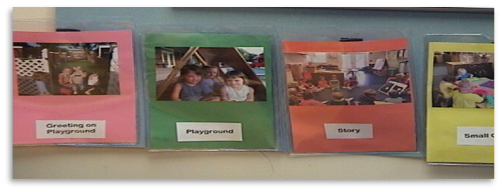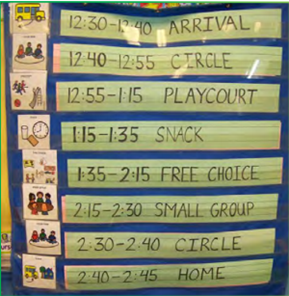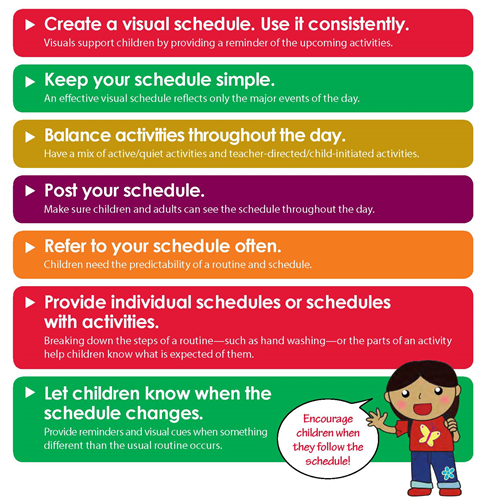When planning the schedule you want to provide balance. This includes:
Child-Initiated Play and Teacher-Guided Activities
The daily schedule balances child-initiated play and teacher-guided activities. The latter involves teachers planning, introducing, and guiding specific activities to enhance children’s learning during small- and large-group times. In contrast, child-initiated play refers to children’s responses to ideas and materials introduced by teachers that the children are free to explore without teacher guidance. Child-initiated play also includes those times when children create, organize, and engage in activities completely on their own.
A daily schedule that ensures ample time for children to initiate their own play in well-developed interest areas is critical to the teaching and learning. Young children need ample time to engage in play, in the company of peers, in order to build their ideas, to pose problems, to try out solutions, and to negotiate and exchange ideas. When children initiate, organize, and develop their own play in the interest areas, it is called child-initiated learning. At times, children choose to play alone, but frequently, child-initiated play takes place in small groups of their own choosing.
In a schedule with ample time for children to initiate play in well-stocked interest areas, there are times when teachers organize and guide specific activities for children. Such teacher-guided curriculum activities are clearly distinct from child-initiated curriculum activities. Teacher-guided activities occur in two contexts—small groups and large groups. A small group would consist of one teacher working with a group of four to eight children. A large group is typically a gathering of all the children in an early childhood setting. Each context serves a different purpose and requires different preparation and different teaching strategies.
For some aspects of the curriculum, teachers may choose to organize an activity with a small group of children. Although initiated and guided by the teacher, an effective small-group encounter of this nature should still be rich in possibilities for children to contribute and negotiate ideas with each other. Teacher-guided activities in small groups work best in quiet spaces away from distractions of the full group and provide a manageable context for children to discuss and explore ideas and experiences. The teacher listens to children’s ideas, helps orchestrate the give-and-take of ideas among children, and poses ideas or problems for children to wonder about, explore together, or even solve. Away from the distractions of a large group, teachers can easily observe, listen, and converse with children in a small group, as well as note how individual children think, express ideas, relate with others, and use their emerging skills.
Such teacher-guided conversations can enrich children’s learning in all domains, particularly the children’s language and vocabulary development. In addition, teachers can intentionally guide the development of specific skills by planning small-group activities (e.g., songs, games, shared reading) for short periods of time that playfully engage children in using specific emerging skills.
Small-group activities have several advantages over large-group activities. With small groups of children, teachers can readily observe, listen, and document children’s developmental progress. Teachers can also individualize the curriculum and use questions or prompts to scaffold each child’s thinking in more complex ways.
Whether the activities are child-initiated or teacher-guided, children’s use of materials in interest areas provide teachers with excellent opportunities to observe how they build concepts and skills and how they negotiate ideas with others. Moments of observed play and interactions also provide teachers with ideas on how to extend children’s exploration and learning through future encounters with related materials that add novelty, challenge, and complexity in each domain.
Large groups provide another context for teacher-guided activities. The large group—typically a gathering of the entire class—works well for singing, acting out songs and stories, playing games, sharing experiences with each other, telling stories, building a sense of community, and organizing the daily schedule and activities. Storytelling is one of the more popular large-group experiences, one that has rich potential for adding to children’s understanding about the world around them. Storytelling allows teachers, children, family members, as well as storytellers from the community to tap into and build children’s knowledge and experiences in meaningful ways. Large-group time is also when teachers let the whole group of children know what new experiences will be available in the interest areas or what will happen in small groups that day. Large-group gatherings that occur at the end of the day provide opportunities to review noteworthy happenings and to anticipate what will be available the next day.[6]
Here are some examples of daily schedules for preschool classrooms.
Table 5.1: Half-Day Program Sample
|
Time of Day
|
Routine/Activity
|
Description
|
|
8:00
|
Arrival/Greetings
|
Wash Hands, Sign-in, Get Name tags
|
|
8:05-8:20
|
Group Time
|
Welcome, Songs, Stories, Discussions
|
|
8:20-9:30
|
Open Choice Time Outdoors
|
Explore classroom areas
|
|
9:30
|
Clean-up
|
Wash Hands, transition to indoors
|
|
9:35-10:45
|
Snack/Open Choice Indoors
|
|
|
10:45
|
Clean-up
|
|
|
10:50-11
|
Closing Circle
|
|
Table 5.2: Full Day Program Sample Daily Schedule[7]
|
Time of Day
|
Routine/Activity
|
Description
|
|
8:00
|
Arrival/Greetings
|
Wash Hands, Sign-in, Get Name tags
|
|
8:05-8:20
|
Group Time
|
Welcome, Songs, Stories, Discussions
|
|
8:20-9:30
|
Open Choice Time Outdoors
|
Explore classroom areas
|
|
9:30
|
Clean-up
|
Wash Hands, transition to indoors
|
|
9:35-11:00
|
Snack/Open Choice Indoors
|
|
|
11:00
|
Clean-up
|
|
|
11:10-11:25
|
Story Time
|
Transition to wash hands for lunch
|
|
11:30-11:50
|
Lunch
|
|
|
11:50
|
Explore books on rest Mats
|
|
|
12:10-2:00
|
Rest Time
|
|
|
2:00-3:15
|
Indoor Choice Time/Snack
|
|
|
3:15
|
Clean-up
|
|
|
3:20
|
Large Group Circle
|
Games, Songs, Stories
|
|
3:40
|
Explore Outdoors
|
|
|
5:00
|
Clean-up
|
|
|
5:05
|
Indoor Small Group/Choice Centers
|
Fewer areas open
|





